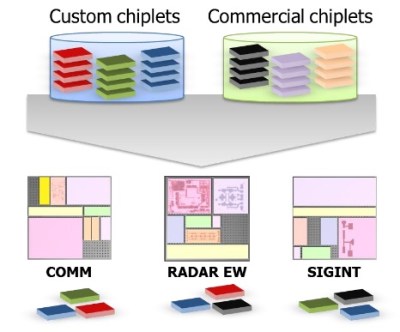
The Defense Department’s research arm has officially kicked off its effort to create a modular computing framework[1], with pieces pulled from a mix-‘n-match set of “chiplets.” Producing something this weird will take a village, the agency suggested — in fact, “an enormous village rife with innovators.” DARPA did always have a way with words.
The program, first announced last year, is called Common Heterogeneous Integration and Intellectual Property Reuse Strategies, which they abbreviate to CHIPS. It’s been reaching out to universities, military-industrial contractors, and of course the semiconductor and chip biz to explore the possibility, and this week was the “proposers’ day,” when the agency and interested parties share details and expectations.
 Basically the idea is to reduce certain functions to standard chiplet size and form factor, within reason, and create a system by which those chiplets can be organized into larger boards. Need a board that’s heavy on image processing and storage for a satellite or recon drone? Put a bunch of those pieces together. Want something more focused on low-latency signal processing and integrating input from multiple sensors? Forget the image stuff and snap in some other parts.
Basically the idea is to reduce certain functions to standard chiplet size and form factor, within reason, and create a system by which those chiplets can be organized into larger boards. Need a board that’s heavy on image processing and storage for a satellite or recon drone? Put a bunch of those pieces together. Want something more focused on low-latency signal processing and integrating input from multiple sensors? Forget the image stuff and snap in some other parts.
A slide deck presented at the event this week[2] (PDF) has lots more details, though since the project is still in early stages it’s all still pretty speculative.
 It’s unclear what size or form the chiplets would take — that’s up to the creators, the innovators in that enormous village, to decide. It could be macro-level swapping in, like popping in extra RAM or a PCI card. Or it could be baked in at the manufacturing level but still more flexible than existing custom chip systems.
It’s unclear what size or form the chiplets would take — that’s up to the creators, the innovators in that enormous village, to decide. It could be macro-level swapping in, like popping in extra RAM or a PCI card. Or it could be baked in at the manufacturing level but still more flexible than existing custom chip systems.
Ideally, though, the resulting electronics would be smaller, more versatile,...